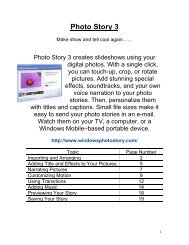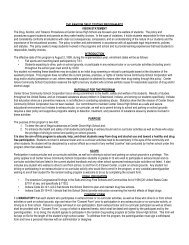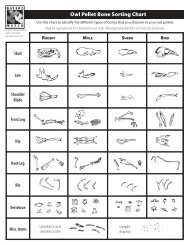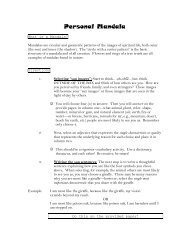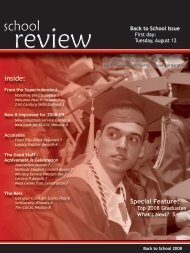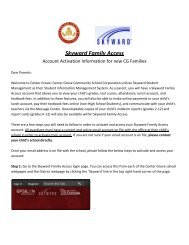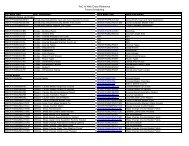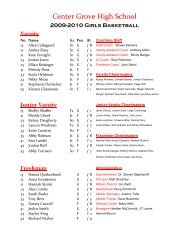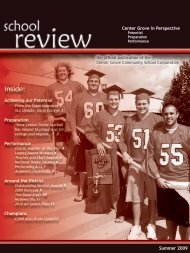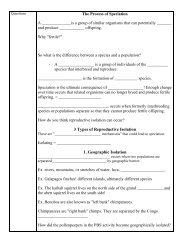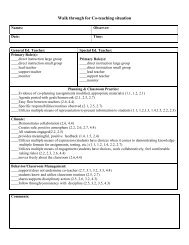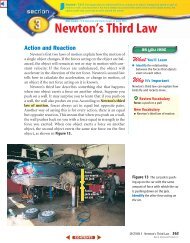The First 20 Days of Reading: Intermediate - Center Grove ...
The First 20 Days of Reading: Intermediate - Center Grove ...
The First 20 Days of Reading: Intermediate - Center Grove ...
Create successful ePaper yourself
Turn your PDF publications into a flip-book with our unique Google optimized e-Paper software.
Day 1<br />
<strong>The</strong> <strong>First</strong> <strong>20</strong> <strong>Days</strong> <strong>of</strong> <strong>Reading</strong>: <strong>Intermediate</strong><br />
Description <strong>of</strong> Lessons<br />
Read Aloud & Independent <strong>Reading</strong><br />
Read Aloud: <strong>Reading</strong> is Thinking!<br />
Teacher will model how they think as they read. Teacher will think aloud throughout the read aloud (before, during, and<br />
after they read). <strong>The</strong> emphasis is on making students aware <strong>of</strong> their own reader voice through an explicit Think Aloud<br />
where the teacher models listening to their own reader voice.<br />
Teacher might say: Have you ever stopped to listen to the little voice in your head as you read I call this my reader<br />
voice and this voice helps me think about and understand what I’m reading – it’s really smart! Today, I want to show you<br />
how I stop and listen to my reader voice as I read. I’ve chosen this book to share with you today, titled (fill-in name <strong>of</strong><br />
book) and as I read it aloud to you I’m going to be stopping, listening to my reader voice, and sharing with you what this<br />
little voice inside my head is thinking and telling me.<br />
At the end <strong>of</strong> the read aloud, bring attention to the blank <strong>Reading</strong> Is Thinking Chart and facilitate a discussion about how it<br />
is truly impossible to read without thinking – you just can‟t stop that reader voice from talking to you! Be sure to talk<br />
about how you will be building this chart together – as you each listen to your own reader voice.<br />
<strong>Reading</strong><br />
Is<br />
Thinking!<br />
Listen to the Reader Voice in Your Head.<br />
Independent <strong>Reading</strong>: Selecting Books and Enjoying Silent <strong>Reading</strong><br />
Today‟s lesson will focus on introducing the system you have set-up for selecting and returning books in your classroom<br />
library and your expectations for the noise level in the classroom during independent reading. In establishing these<br />
systems, keep your own comfort level in mind. You‟ll want to consider:<br />
How you will organize the texts in your library (genre, topics, authors, etc… divided by shelves, baskets, labels,<br />
etc…)<br />
How <strong>of</strong>ten students will be allowed to go to the library and switch-out their selections<br />
Will each student be responsible for returning his or her own selections<br />
Are you most comfortable with silence during independent reading so that you can conduct conferences without<br />
interruption<br />
Where will students be during the independent reading time – assigned seats, spots <strong>of</strong> their choice, assigned places<br />
other than their usual seats<br />
Be certain that there is time allotted for students to read on this first day. This will be a good time for you to walk around<br />
and spot check selections. <strong>The</strong>se observations will guide your planning for Day 2.<br />
Your chart may look like this:<br />
Using Our Classroom Library:<br />
All books are returned to the spot from<br />
which they were taken.<br />
Books are placed on shelves with their<br />
spine facing out.<br />
Austin Independent School District, Elementary Language Arts Department, ‟08-„09
Day 2<br />
Read Aloud: <strong>Reading</strong> is Thinking! – Interactive Think Aloud (S)<br />
Teacher will refer back to yesterday‟s introduction <strong>of</strong> <strong>Reading</strong> is Thinking – Listening to Our Reader Voices. Today,<br />
teachers will invite students to Think Aloud with them as they read aloud.<br />
Teacher might say: Yesterday, we talked about the reader voice in my head and I showed you how I stop and listen to my<br />
reader voice as I read so that I can really think about what I’m reading and what it all means. Today, we’re going to do<br />
this together. I want you to listen to your own reader voice as I read aloud. We’ll be stopping from time to time to share<br />
our thoughts. I’ve chosen some places to stop, but if your reader voice is shouting out inside your head you can stop us<br />
too by raising your hand and you’ll be able to share what you’re thinking with all <strong>of</strong> us.<br />
As students share their thoughts, be sure to label each. For example, if a student says, “When you read that part it made<br />
me wonder how (character name) felt.” You might reply by saying, “So by putting yourself in (character name’s) place<br />
your reader voice then had a question or a wondering about something that’s really important to understanding the story<br />
– the character’s feelings.” ***<strong>The</strong> IPG focus for the week is character. You will want to plan some explicit talk about<br />
character during this discussion without limiting the discussion to character analysis.***<br />
This is also a good time to begin using Accountable talk stems, such as:<br />
“What I hear you saying is…”<br />
“What do you think about (student‟s) question (student)<br />
“What did (student) just say”<br />
“Asking questions is something good readers do.”<br />
Big points to make today are:<br />
It is impossible to stop your reader voice<br />
Talking about our thinking helps all <strong>of</strong> us to understand the text more fully and to become better readers<br />
Add a couple <strong>of</strong> patterns <strong>of</strong> thought that have surfaced in your classroom to the <strong>Reading</strong> is Thinking! Chart<br />
Independent <strong>Reading</strong>: Making Good Book Choices (S)<br />
<strong>The</strong> focus <strong>of</strong> today‟s lesson is to establish clear criteria for choosing just-right books during independent reading time.<br />
Just as important as allotting time for reading is ensuring that the books students are reading during the independent<br />
reading time are those that will benefit them most as readers. Readers should choose just right books. Because you want<br />
students to have plenty <strong>of</strong> choice, they must have specific strategies for choosing these just right books independently.<br />
You will develop a chart with students that will clearly define what a Just Right book is in your classroom. It is important<br />
to remember that students will be able to identify and articulate these ideas if they have an explicit model <strong>of</strong> an Easy, Just-<br />
Right, and Hard book. Teachers should bring in examples <strong>of</strong> each <strong>of</strong> these types <strong>of</strong> books for themselves and read aloud<br />
small portions <strong>of</strong> each book for the students emphasizing the characteristics they want students to identify.<br />
Choosing a Just Right Book<br />
This is a sample chart<br />
that teachers can use as<br />
a guide. It should not be<br />
prepared ahead <strong>of</strong> time as<br />
students will help to create<br />
this chart in their classroom.<br />
Easy Books:<br />
You can read all the words.<br />
You understand all <strong>of</strong> the ideas.<br />
You have read it many time before and can<br />
read it fluently/smoothly.<br />
**Just Right Books**:<br />
You can read almost all <strong>of</strong> the words.<br />
You understand most <strong>of</strong> the ideas, but there<br />
are some things that make you think.<br />
You‟re interested in the book.<br />
You can read most <strong>of</strong> it fluently.<br />
Hard Books:<br />
<strong>The</strong>re are many words that you don‟t know<br />
or understand.<br />
It doesn‟t make sense to you.<br />
It‟s confusing.<br />
You wouldn‟t be able to talk to someone<br />
about what you‟re reading.<br />
For ideas for Strategies for Selecting Just-Right Books refer to Regie Routman‟s <strong>Reading</strong> Essentials, pg. 93 and Appendix<br />
E, pg. A-6<br />
Austin Independent School District, Elementary Language Arts Department, ‟08-„09
Day 3<br />
Day 4<br />
Read Aloud: <strong>Reading</strong> is Thinking! – Thinking, Talking, and Writing About Your <strong>Reading</strong> (S)<br />
Teacher will refer back to the <strong>Reading</strong> is Thinking! Chart that the class has been building, making note <strong>of</strong> how students<br />
and teachers have been sharing their thoughts orally. Teacher will then model using sticky notes to maintain a written<br />
record <strong>of</strong> their thinking as they read.<br />
Teacher might say: Over the last two days we’ve really worked at listening to our reader voice as we read and we’ve been<br />
sharing our thoughts with each other. Today, I want to show you what I do so that I have a way to remember my thoughts.<br />
As I read and record my thoughts, I want you to be thinking about how this helps me as a reader.<br />
Facilitate a discussion about why it‟s important for readers to record their thinking and how this helps them to build their<br />
understanding <strong>of</strong> the text. As we read we might refer back to a question, observation, prediction and adjust or confirm our<br />
initial thoughts thereby continuously and fluidly building our understanding <strong>of</strong> the text.<br />
***<strong>The</strong> IPG focus for the week is character. You will want to plan some explicit talk about character during this<br />
discussion without limiting the discussion to character analysis.***<br />
Independent <strong>Reading</strong>: Recording our Thinking as We Read (S) & Storing and Maintaining our Personal Independent<br />
<strong>Reading</strong> Selections (M)<br />
Teacher will introduce system for storing independent reading materials. At this point, these materials with include:<br />
selected books, sticky notes, pencil, and bookmarks. Teacher should also refer back to the Choosing a Just-Right Book<br />
criteria that were established the previous day.<br />
Students will be asked to actively use their sticky notes to record their thinking as they read during independent reading<br />
today. This will reinforce the mini-lesson from Read Aloud. Teacher should actively check-in with students regarding<br />
both book selections and recording their thinking on sticky notes.<br />
Some things to consider:<br />
How could the Independent <strong>Reading</strong> time be structured today, so that small groups <strong>of</strong> children are given time to<br />
practice choosing a Just-Right book with teacher support<br />
Where in the classroom will students store their Independent <strong>Reading</strong> materials<br />
How many books will each student be able to store with their Independent <strong>Reading</strong> materials<br />
Can you build-in time for a few students to share how they are recording their thinking as they read<br />
Read Aloud: <strong>Reading</strong> is Thinking! – More Ways to Think as We Read (S)<br />
Teacher will refer back to the <strong>Reading</strong> is Thinking! Chart and highlight any ideas that have been added to the chart thus<br />
far. Teacher will ask, Do you think that my reader voice tells me the same things that your reader voice tells you Are we<br />
all thinking the same things as we read a book together Teacher will then facilitate a discussion around these questions.<br />
Next, teacher might say, Today, as we listen to our reader voices, we’ll stop to write down our own thoughts before we<br />
share. I wonder if we’ll be thinking the same things or different things<br />
During the read aloud stop at predetermined placed in the text and have all students write their thoughts on sticky notes<br />
that you have provided. <strong>The</strong>n ask several students to share their thinking. Highlight the differences in each student‟s ideas<br />
and thoughts and identify the commonalities.<br />
Big points to make today:<br />
We all have different thoughts as we read because <strong>of</strong> our individual schemas or backgrounds.<br />
Despite our individual ways <strong>of</strong> thinking as we read, there are some common patterns <strong>of</strong> thought that occur among<br />
readers, such as connections, predictions, questions, etc…<br />
***<strong>The</strong> IPG focus for the week is character. You will want to plan some explicit talk about character during this<br />
discussion without limiting the discussion to character analysis.***<br />
For more on ways readers think refer to Fountas & Pinnell‟s Teaching for Comprehension & Fluency, Chapter 3, pg. 32.<br />
Independent <strong>Reading</strong>: <strong>The</strong> <strong>Reading</strong> Conference – Part 1 (M, S)<br />
Teacher will introduce the Independent <strong>Reading</strong> Conference protocol to students. <strong>The</strong> suggested protocol is outlined on<br />
the Informal <strong>Reading</strong> Conference Form attached. Teachers may want to enlarge this form to share it with students.<br />
Points to make:<br />
During a conference we‟ll check to be sure that you are choosing books appropriately based on our Choosing a<br />
Just-Right Book criteria.<br />
<strong>The</strong> independent reading conference is an opportunity to talk about your reading.<br />
During a conference we‟ll talk about how you‟re reading (strategies for sustaining your reading) as well as the big<br />
ideas in the texts (how you‟re thinking as you read).<br />
Things to consider:<br />
In order to be able to confer with 3-4 students per day, how long should each conference be<br />
How will you facilitate conferences so that students are given the opportunity to show that they have chosen<br />
appropriate texts and understand what they are reading<br />
Will students be responsible for setting goals during their conferences<br />
How will you organize and maintain your records for conferences<br />
How will you ensure that over the course <strong>of</strong> the next 2 weeks you are able to confer with all <strong>of</strong> your students<br />
Austin Independent School District, Elementary Language Arts Department, ‟08-„09
Day 5<br />
Read Aloud: <strong>Reading</strong> is Thinking! – Let’s think about our Thinking (S)<br />
<strong>The</strong> focus <strong>of</strong> today‟s lesson is the meta-cognitive process. Not only do we want students to be aware <strong>of</strong> their reader voice,<br />
we want them to be able to accurately identify what strategies they are using.<br />
Teacher might say: Today we’re going to think about our thinking. We’ve been listening carefully to our reader voice and<br />
sharing our thoughts with each other. Today, we’ll continue to do that and we’ll also think and talk about the kinds <strong>of</strong><br />
thoughts we’re having as we read. So, if I’m reading along and I think – I wonder what (character name) will do next –<br />
I’ll share that thought with you and then I’ll note that I had a question. As we read, I want you to think about how doing<br />
this will help us as readers.<br />
Some things to consider as you plan for Day 5:<br />
It is important for all readers (adults and students alike) to know which strategies they actively and easily use as they<br />
process text. This information helps readers know which strategies they must make a conscious effort to practice in order<br />
for them to become a part <strong>of</strong> their “bag <strong>of</strong> tricks”. Knowing yourself as a reader is the first step to becoming a better<br />
reader.<br />
Make Connections<br />
At the end <strong>of</strong> the week, your<br />
<strong>Reading</strong> is Thinking! Chart might<br />
look like this:<br />
Ask Questions<br />
<strong>Reading</strong><br />
Is<br />
Thinking!<br />
Think about<br />
Characters<br />
Find answers<br />
to my questions<br />
Listen to the Reader Voice in Your Head.<br />
***<strong>The</strong> IPG focus for the week is character. You will want to plan some explicit talk about character during this<br />
discussion without limiting the discussion to character analysis.***<br />
Independent <strong>Reading</strong>: <strong>The</strong> <strong>Reading</strong> Conference – Part 2 An Example (M, S)<br />
Teacher will revisit the Independent <strong>Reading</strong> Conference protocol with students. Teacher will select a student with whom<br />
they can model an effective Independent <strong>Reading</strong> Conference as the rest <strong>of</strong> the class observes. Students will share what<br />
they noticed about both the teacher‟s talk and the student‟s talk. Teacher will facilitate a discussion that focuses on the<br />
major points outlined below.<br />
Points to make:<br />
Conferences are a check-point for both the teacher and the student. We‟ll check to be sure that you are choosing<br />
books appropriately based on our Choosing a Just-Right Book criteria.<br />
<strong>The</strong> independent reading conference is an opportunity to talk about your reading.<br />
During a conference we‟ll talk about how you‟re reading (strategies for sustaining your reading) as well as the big<br />
ideas in the texts (how you‟re thinking as you read).<br />
Things to consider:<br />
In order to be able to confer with 3-4 students per day, how long should each conference be<br />
How will you facilitate conferences so that students are given the opportunity to show that they have chosen<br />
appropriate texts and understand what they are reading<br />
Will students be responsible for setting goals during their conferences<br />
How will you organize and maintain your records for conferences<br />
How will you ensure that over the course <strong>of</strong> the next 2 weeks you are able to confer with all <strong>of</strong> your students<br />
Austin Independent School District, Elementary Language Arts Department, ‟08-„09
Day 6<br />
Day 7<br />
Read Aloud, Shared <strong>Reading</strong>, and Independent <strong>Reading</strong><br />
Read Aloud – Shortened Time: Previewing Text (S)<br />
Today teachers will facilitate a discussion about how readers preview books before deciding to read them. This should be<br />
a whole class discussion with the students actively participating in creating a chart for how they preview books.<br />
Teacher might say: Whenever I’m ready to read a new book, I like to take some time and choose my next book carefully.<br />
Last night, I was trying to decide what book to read next and I noticed that I have some very specific things that I do when<br />
I’m previewing a book. One <strong>of</strong> the things I do, is I read the title and this gets my reader voice going and thinking about<br />
whether or not I’d be interested in reading the book. I’m going to write that on our chart and I want to hear about some <strong>of</strong><br />
the things you do when you preview a book.<br />
As students share their strategies for previewing a book, teachers will use the pre-selected texts (both fiction and nonfiction)<br />
to model and reinforce what students are sharing.<br />
Your chart might look like this:<br />
Ways We Preview Text:<br />
Think about the title<br />
Read the information on the back cover<br />
Try the beginning<br />
Try a little from the middle<br />
Think about genre<br />
Shared <strong>Reading</strong>: Previewing Text (S)<br />
Today is the first day for shared reading. Teachers will want to take a few minutes to introduce this instructional format to<br />
students. It‟s important to be explicit in your explanation so that students understand that shared reading is a time for<br />
students to actively help the teacher process text. During this time students will be given many opportunities to practice<br />
the strategies and skills they are learning during Read Aloud.<br />
Using a non-fiction and fiction example at the overhead, the teacher will ask students to help him/her preview the text in<br />
order to decide if it is something they are interested in reading. Your selections can be one-page articles or can be<br />
overheads made from read aloud selections. Teachers will want to mark each time a student suggest previewing the text<br />
by using a strategy from the Ways We Preview Text Chart.<br />
Independent <strong>Reading</strong> – Extended Time: Previewing Text (S)<br />
<strong>The</strong> focus for the independent reading time today is for students to refer to the Ways We Preview Text Chart as they<br />
choose books to read during independent reading. <strong>The</strong> teacher will want to monitor student choices and explicitly ask<br />
students questions about how they chose their text.<br />
Things to consider:<br />
How much time should be dedicated to independent reading today so that all students are able to practice making<br />
good book choices by choosing just-right books and previewing them carefully<br />
How will you monitor this process<br />
Should all students practice this at the same time or should you call small groups to the classroom library<br />
Students and teacher will also continue to work on establishing a quiet Independent <strong>Reading</strong> time so that all readers can do<br />
their best thinking.<br />
Read Aloud: Distinguishing between Fiction and Non-Fiction Text (L)<br />
Using examples <strong>of</strong> both fiction and non-fiction text from the read aloud selections, teachers will facilitate a discussion<br />
about distinguishing between fiction and non-fiction text. <strong>The</strong> discussion should focus on how text features help readers<br />
identify and distinguish between fiction and non-fiction text. It is important for students to be pr<strong>of</strong>icient at distinguishing<br />
fiction and non-fiction because <strong>of</strong> the distinct ways in which each text is processed. We also want to encourage students to<br />
balance their reading between fiction and non-fiction texts.<br />
After a short discussion regarding the distinction between fiction and non-fiction texts, teacher should read aloud from a<br />
fiction text and reinforce students‟ ways to identify fiction. ***Imbedded in this conversation should be a continuing<br />
conversation around character analysis.***<br />
Austin Independent School District, Elementary Language Arts Department, ‟08-„09
Day 8<br />
Shared <strong>Reading</strong>: Distinguishing between Fiction and Non-Fiction Text (L)<br />
This will be a short lesson that will provide an additional opportunity for students to practice distinguishing between<br />
fiction and non-fiction text. Overheads <strong>of</strong> 3-4 examples should be prepared to share with students. As each piece is<br />
placed on the overhead students can work in table groups or partners to turn-and-talk about whether they think the text is<br />
fiction or non-fiction and why. Students should be asked to share their thinking.<br />
Independent <strong>Reading</strong>: Balancing our reading between Fiction and Non-Fiction (M)<br />
Today‟s talk during Independent <strong>Reading</strong> builds on the Read Aloud and Shared <strong>Reading</strong> lessons. <strong>The</strong> focus will be on<br />
providing concrete reasons for balancing our reading between fiction and non-fiction texts. Some benefits to consider are:<br />
building your vocabulary<br />
establishing flexibility with language<br />
practicing the different ways to process text effectively by reading a variety <strong>of</strong> texts<br />
Read Aloud: <strong>Reading</strong> is Thinking! – Thinking about Text Features within Fiction Text (S) Extended Time<br />
Before reading aloud the selected fiction text for today, teacher will refer back to yesterday‟s discussion regarding using<br />
text features to distinguish between fiction and non-fiction text.<br />
After a brief “walk” through the selected text, students should be asked to identify the text as either fiction or non-fiction.<br />
Distinguishing features for fiction include:<br />
Text Features<br />
• Illustrations<br />
• Dialogue<br />
• Continuous text<br />
• Bold text<br />
Story Form<br />
• Characters<br />
• Setting<br />
• Plot<br />
• Problem<br />
• Solution<br />
Just before reading, teacher might say: We have already done so much thinking before we even start reading our book for<br />
today and now we know that this book titled (insert book title here) is fiction. As we read today, we want to think carefully<br />
about how the text features we’ve identified – illustrations, dialogue, etc… - help us understand the ideas and the<br />
characters in the story better. Does paying close attention to the dialogue help Does looking closely at the illustrations<br />
support our understanding Let’s remember that <strong>Reading</strong> is Thinking! And let’s share our thoughts as we read today.<br />
***<strong>The</strong> IPG focus for the week is character. You will want to plan some explicit talk about character during this<br />
discussion without limiting the discussion to character analysis.***<br />
Shared <strong>Reading</strong>: No Shared <strong>Reading</strong> today<br />
Independent <strong>Reading</strong>: Making Public the Guidelines for Independent <strong>Reading</strong> or the Reader’s Workshop (M)<br />
By Day 8 <strong>of</strong> Independent <strong>Reading</strong> many <strong>of</strong> the routines have been established and practiced. Today these routines and<br />
expectations will be made public through the use <strong>of</strong> a Our Independent <strong>Reading</strong> or Reader’s Workshop chart.<br />
Fountas & Pinnell suggest<br />
these guidelines:<br />
Our Reader’s Workshop:<br />
You must always be reading a book or<br />
writing your thoughts about your<br />
reading.<br />
You need to work silently to enable you<br />
and your peers to do your best thinking.<br />
Use a s<strong>of</strong>t voice when conferring with a<br />
teacher.<br />
Select books by thinking about what is<br />
just-right for you and previewing them<br />
carefully.<br />
Everyone is responsible for their own<br />
materials, that includes books, pencil,<br />
and sticky notes.<br />
This can be added after it is discussed:<br />
Record what you are reading in your<br />
Reader‟s Notebook.<br />
For this lesson it is suggested that<br />
the chart be prepared ahead <strong>of</strong><br />
time since it is based on things that<br />
have already been discussed with<br />
students. Any additional suggestions<br />
from students can be added.<br />
Austin Independent School District, Elementary Language Arts Department, ‟08-„09
Day 9<br />
Day 10<br />
Read Aloud: <strong>Reading</strong> is Thinking! – Thinking about Character – Part 1 (S)<br />
<strong>The</strong> focus <strong>of</strong> today‟s lesson is Character Analysis. Understanding a primary character well enhances a reader‟s<br />
comprehension <strong>of</strong> the implicit message in the text.<br />
Before reading the selected text the teacher might say: We’ve talked a lot about thinking as we read and paying close<br />
attention to the kind <strong>of</strong> thinking we’re doing. We’ve noticed that each <strong>of</strong> us has different thoughts as we read even when<br />
we’re reading the same book. Today, I’m going to ask you to focus your thinking on the main character <strong>of</strong> the story I’ll be<br />
sharing with you today. Sometimes we’re asked to think in very specific ways and today is one <strong>of</strong> those days. We’ll<br />
continue to make connections, ask questions, make predictions, etc…as well as pay special attention to what the main<br />
character is saying, doing, feeling, and thinking so that we can really understand them and the story as a whole better.<br />
A Character Analysis Graphic Organizer can be used to facilitate the discussion.<br />
Be sure to segment the text and plan for stops points with questions that will encourage students to think deeply about the<br />
main character in the story.<br />
Because <strong>of</strong> the depth <strong>of</strong> discussion, during this lesson, it is recommended that you use the same text on Day 9 and Day 10.<br />
Shared <strong>Reading</strong>: <strong>Reading</strong> is Thinking! – Thinking about Character (S)<br />
This lesson is a continuation <strong>of</strong> the mini-lesson during Read Aloud. One or two pages from the selected text can be made<br />
into overheads and used for choral reading and thinking about Character.<br />
Independent <strong>Reading</strong>: <strong>The</strong> Reader’s Notebook - Keeping a Record <strong>of</strong> Your <strong>Reading</strong> (M)<br />
Today you will introduce the Reader‟s Notebook to students. This notebook can be organized in many ways. One<br />
suggestion is to use a pocket folder with brads and include:<br />
In the front pocket – A <strong>Reading</strong> Log<br />
In the brads – Blank notebook paper<br />
In the back pocket – empty for now (Later, fluency checks can be kept here.)<br />
Using an Enlarged <strong>Reading</strong> Log or an overhead <strong>of</strong> the <strong>Reading</strong> Log (sample attached), model for students how to fill-in all<br />
the information on the log. Explain that this log will help everyone to evaluate their reading, keeping in mind that there<br />
should be a balance between fiction and non-fiction. (Later, you‟ll discuss wide-reading with your students and the log<br />
will also help with this.)<br />
Read Aloud: <strong>Reading</strong> is Thinking! – Thinking about Character – Part 2 (S)<br />
Using the text that was started on Day 9, continue reading aloud and engaging the students in a conversation about<br />
character. Today the conversation shifts from simply making observations about the character to adjusting our thoughts on<br />
the character based on their interactions with other characters and their setting. <strong>The</strong> focus is:<br />
Readers work to understand the characters in their books as a way to understand the larger ideas in text.<br />
Readers continuously revise their understanding <strong>of</strong> characters as they respond to their interactions with other<br />
characters and their setting.<br />
<strong>The</strong> central character in a book provides the reader with insight about the author‟s message.<br />
Shared <strong>Reading</strong>: No Shared <strong>Reading</strong> today<br />
Independent <strong>Reading</strong>: Wide <strong>Reading</strong> (M)<br />
Wide <strong>Reading</strong> refers to reading a variety <strong>of</strong> text types. In the intermediate grades, many students are naturally drawn to<br />
chapter books (novels). While chapter books are an excellent choice, limiting selections to chapter books does not provide<br />
the reader with the opportunities to:<br />
build their vocabulary<br />
enhance their flexibility with language and language structure<br />
practice processing a variety <strong>of</strong> text effectively<br />
Using a selection <strong>of</strong> 5-7 carefully chosen picture books from a variety <strong>of</strong> genre and 1 chapter book (novel), teacher will<br />
facilitate a discussion about reading widely.<br />
Teacher might say: I’ve noticed that many <strong>of</strong> us are choosing chapter books to read during independent reading. We do<br />
have some excellent choices in our classroom and I’m glad to see that you’ve found some to enjoy. Today, I want to talk<br />
to you about varying your selections so that you’ll have the opportunity to read many more books in our classroom. Let’s<br />
take a look at the books that I’ve chosen…<br />
You‟ll want to point out that:<br />
there are certain things that you learn from each book that you read<br />
each author has a special way <strong>of</strong> writing and reading many different books by many different authors helps you<br />
become an expert at processing text effectively regardless <strong>of</strong> the structure <strong>of</strong> the language<br />
in the time that you can read 1 novel or chapter book, you could read 5-7 picture books and learn so much more<br />
<strong>The</strong> goal for today is to come to a compromise with your students regarding the number <strong>of</strong> picture or trade books that<br />
they‟ll read for every chapter book or novel that they read. A reasonable compromise is 5-7 picture or trade books for<br />
every chapter book or novel. Remember that picture books include both fiction and non-fiction and are written at many<br />
different levels. 5 th graders may enjoy reading Seymour Simon non-fiction books and Chris Van Allsburg fiction books.<br />
Austin Independent School District, Elementary Language Arts Department, ‟08-„09
Day 11<br />
Read Aloud, Shared <strong>Reading</strong>, and Independent <strong>Reading</strong><br />
Read Aloud: <strong>Reading</strong> is Thinking! – Different Kinds <strong>of</strong> Fiction (L)<br />
Today‟s lesson during the read aloud time is designed to provide time for teachers and students to explore the different<br />
kinds <strong>of</strong> fiction that are available to read from the classroom library before reading a personal narrative aloud. Plan on<br />
discussing 3-4 different types <strong>of</strong> fiction including but not limited to realistic fiction and personal narrative.<br />
Things to consider in planning for today‟s lesson:<br />
What characteristics <strong>of</strong> each kind <strong>of</strong> fiction discussed today do you want students to be familiar with at the end <strong>of</strong><br />
the lesson<br />
How will you make these characteristics public<br />
Is your library organized in a way that supports this discussion<br />
Do you want to label these genres in your classroom library<br />
It is suggested that the personal narrative that is read aloud today also be the resource for Shared <strong>Reading</strong>. One to two<br />
pages can be made into overheads in order to continue the conversation regarding characteristics <strong>of</strong> different kinds <strong>of</strong><br />
fiction.<br />
***<strong>The</strong> IPG focus for the week is sequence. You will take a close look at sequence later in the week, but you will want<br />
to plan some explicit talk about sequence as you look at fiction.***<br />
Shared <strong>Reading</strong>: Different Kinds <strong>of</strong> Fiction – Personal Narrative (L)<br />
This shared reading lesson is an extension <strong>of</strong> today‟s read aloud lesson. It is suggested that the personal narrative that is<br />
read aloud today also be the resource for Shared <strong>Reading</strong>. One to two pages can be made into overheads in order to<br />
continue the conversation regarding characteristics <strong>of</strong> different kinds <strong>of</strong> fiction.<br />
Points to reinforce prior to or during choral reading and discussion <strong>of</strong> the text:<br />
A Personal Narrative is characterized by an event, incident, or experience in the writer‟s own life or in the life <strong>of</strong> a<br />
fictional character.<br />
Personal Narratives can be categorized under both fiction and non-fiction, depending on the artistic license the<br />
writer has taken in conveying the story<br />
Teacher might say: A personal narrative is a very interesting genre or text type because it can be either fiction or nonfiction.<br />
It is fiction when the author has written the story in first person, using I, from the perspective or point <strong>of</strong> view <strong>of</strong> a<br />
made-up character. It’s non-fiction when the story is from the writer’s own life. Today we are looking at a fiction<br />
personal narrative.<br />
Independent <strong>Reading</strong>: Writing Responses to Your <strong>Reading</strong> (M)<br />
Today teachers will introduce students to the Reader‟s Response Letter that they will be writing each week. Students will<br />
have a first try at writing their own letter after reading an example from the teacher. This letter will be written on<br />
notebook paper in the Reader‟s Notebook each week.<br />
Fountas & Pinnell suggest that the teacher might say something like this: Together we have shared our thinking by talking<br />
about books I have read aloud to you and by talking about the books you have chosen to read during independent reading.<br />
You have talked about your thinking with your friends and during our conferences and you have kept a record <strong>of</strong> your<br />
thinking using sticky notes as you read. Now, instead <strong>of</strong> just talking about our reading and writing quick notes on stickies,<br />
you’re going to put your thinking on paper. When you write about your thinking, you can remember it and share it with<br />
others who read it. In our class this year, you’re going to share your thinking by writing your thoughts in a letter to me in<br />
your reader’s notebooks. Each week you are going to write one letter to me, sharing what you are thinking about the book<br />
you are reading. I will read your letter and write a letter back to you. I have written a letter to you today to share my<br />
thinking about a book I’m reading.<br />
Teachers will share their letter with the class and then ask, What do you notice about the letter I wrote<br />
After students make observations, teacher might say, This is how I will expect you to write your letters to me. You will<br />
write your best thinking in your best writing <strong>of</strong> a personal letter. Our letters will be a conversation between two readers.<br />
Today you will work on your first letter to me during our independent reading time. Use the blank paper in your reader’s<br />
notebook and place your notebook in the basket when you are finished. At the end <strong>of</strong> our independent reading time, I will<br />
ask a few students to share their letters with the class.<br />
For ideas on a teacher letter to share with your class and facilitating this conversation, see Fountas & Pinnell‟s Guiding<br />
Readers and Writers, Chapter 9, pg. 153.<br />
Austin Independent School District, Elementary Language Arts Department, ‟08-„09
Day 12<br />
Read Aloud: Thinking about <strong>Reading</strong> through a Genre Study – Book Flood (L)<br />
Today teachers will begin a genre study <strong>of</strong> Personal Narrative Text. It will be important to gather many examples <strong>of</strong><br />
Personal Narratives (both fiction and non-fiction) for this study before you introduce it to the students.<br />
As a way to introduce students to this genre study, teacher may want to give students some time (10 minutes or so) to look<br />
through the collection <strong>of</strong> Personal Narratives they have gathered. Students can work with partners to look through the<br />
texts and write down any <strong>of</strong> their observations regarding the text features or text structure. <strong>The</strong>se observations can be<br />
shared and recorded on a Personal Narratives Chart.<br />
Teacher will then read aloud from one Personal Narrative and reinforce all <strong>of</strong> the students‟ observations and adjust ideas if<br />
necessary.<br />
It will be important to make the following points during today‟s lesson:<br />
Recognizing a specific genre prepares a reader for processing the text effectively because they have an idea about<br />
the type <strong>of</strong> writing they will be reading, the story structure, and even the type <strong>of</strong> plot lines that are followed in that<br />
genre.<br />
<strong>The</strong> Personal Narrative Genre tells the story <strong>of</strong> one event in the author‟s life or in the life <strong>of</strong> a fictional character<br />
created by the author.<br />
Please note: 3 rd Grade Teachers may want to switch personal narratives for memoir to match the writing IPGs. <strong>The</strong><br />
strategies and instructional practices outlined would still apply.<br />
***<strong>The</strong> IPG focus for the week is sequence. You will take a close look at sequence later in the week. You will want to<br />
plan some explicit talk about sequence as you look at personal narratives.***<br />
Shared <strong>Reading</strong>: No Shared <strong>Reading</strong> Today<br />
Independent <strong>Reading</strong>: Writing Letters in Your Reader’s Notebook Each Week (M & S)<br />
This lesson is a follow-up to yesterday‟s introduction <strong>of</strong> the Reader‟s Response Letters the students will be writing in their<br />
Reader‟s Notebooks.<br />
Fountas & Pinnell suggest saying something like this: Yesterday we talked about how each week you will be writing a<br />
letter about the book you are reading or have just finished. Many <strong>of</strong> you were able to complete your letter yesterday and<br />
some <strong>of</strong> you shared what you had written. Inside your Reader’s Notebooks today, all <strong>of</strong> you have a typed letter from me<br />
about how you will be sharing your thinking about books in writing this year. Please turn to that page.<br />
Teacher will read the letter aloud to all students. <strong>The</strong>n say, This letter is glued into your notebook to remind you about the<br />
writing you are doing. You can reread it or refer to it when you need reminding <strong>of</strong> what you should be writing. If you<br />
finished your letter last time, you will notice that I have also written a letter back to you. (Typically, this is a hand written<br />
letter in response to the student‟s letter.) You can begin today’s quiet reading time by reading my letter. Next week, when<br />
you write to me, you will want to review the letter to be sure you respond to what I wrote. If you did not finish your letter<br />
yesterday, you will need to do that first today and put your notebook in the completed basket.<br />
Things to consider and clarify for students on this day:<br />
Do you want all <strong>of</strong> your students to write their letters on the same day or do you want to stagger them throughout<br />
the week<br />
Will you write individual letters to each student specifically addressing some <strong>of</strong> the things they wrote about or will<br />
you write one letter to all students and place a copy in each student‟s notebook after reading all <strong>of</strong> the letters for<br />
that week<br />
Will students be writing their letters in the classroom during the independent reading time or will they write their<br />
letters for homework<br />
For more ideas on today‟s lesson see Fountas & Pinnell‟s Guiding Readers and Writers, pg. 153 - 155<br />
Austin Independent School District, Elementary Language Arts Department, ‟08-„09
Day 13<br />
Read Aloud: Thinking about <strong>Reading</strong> through a Genre Study – Connecting with the Author (S)<br />
For today‟s lesson, teacher will highlight one <strong>of</strong> the most common comprehension strategies – Making Connections.<br />
Making connections to the text you are reading may have already been discussed and charted on your <strong>Reading</strong> is<br />
Thinking! chart or it may not have. In either case, this will be your opportunity to discuss and explore this important<br />
strategy with you students – whether you are revisiting or introducing it today.<br />
Readers naturally make connections as they read. <strong>The</strong>se connections can be categorized as: text-to-self, text-to-text, and<br />
text-to-world. Fountas & Pinnell say: <strong>The</strong>se connections create a rich fabric for expanding one’s thinking. [When<br />
readers make connections they]:<br />
Bring background knowledge to the reading <strong>of</strong> the text.<br />
Understand purposes for reading texts.<br />
Interpret texts using personal experiences and knowledge <strong>of</strong> the world.<br />
Connect the topic, characters, plot, and setting to personal experience, knowledge <strong>of</strong> the world, and knowledge <strong>of</strong><br />
other texts.<br />
Make connections between and among texts, noticing similarities and differences.<br />
Relate words to visual images.<br />
Search for relationships among texts using a wide range <strong>of</strong> criteria – the same genre, author, illustrator, topic,<br />
theme, issue, setting, historical period, character, culture, ethnic group, or age group.<br />
Before reading the selected text the teacher might say: Today we’re going to continue our conversation about how<br />
<strong>Reading</strong> is Thinking! I’m sure that like me, you have found that it is impossible to stop the reader voice in your head as<br />
you read. We talked last week about how it is important sometimes to think in very specific ways and today is another one<br />
<strong>of</strong> those days. As always, we’ll continue to do all the great thinking we always do – I can’t imagine not asking questions<br />
while I read – but we will be listening closely to when our reader voice makes a connection to what we are reading. I<br />
want you to also think about why it is important to make connections as we read – how does this help us become better<br />
readers<br />
Be sure to segment the text and plan for stops points with questions that will encourage students to make connections to<br />
the text. After reading the text, facilitate a discussion about the important role making connections plays in understanding<br />
what we are reading.<br />
For more on Making Connections as a Comprehension Strategy see Fountas & Pinnell‟s Teaching for Comprehension &<br />
Fluency, Chapter 5, pgs. 54 – 55.<br />
***<strong>The</strong> IPG focus for the week is sequence. You will take a close look at sequence later in the week. You will want to<br />
plan some explicit talk about sequence as you look at personal narratives.***<br />
Shared <strong>Reading</strong>: Thinking about <strong>Reading</strong> through a Genre Study – Connecting with the Author (S)<br />
This shared reading lesson is an extension <strong>of</strong> today‟s read aloud lesson. It is suggested that the personal narrative that is<br />
read aloud today also be the resource for Shared <strong>Reading</strong>. One to two pages can be made into overheads in order to<br />
continue the conversation regarding making connections to the author‟s ideas as you read.<br />
Teacher will facilitate choral reading and discussion <strong>of</strong> the text throughout the shared reading time. Special attention<br />
should be given to the connections students make throughout the reading and how these connections support a reader‟s<br />
understanding <strong>of</strong> the text.<br />
Independent <strong>Reading</strong>: Topics for Your Reader’s Notebook<br />
Before students begin to read silently today, teachers and students will generate <strong>of</strong> list <strong>of</strong> possible topics to write about in<br />
their Reader‟s Response Journal Letters to the teacher. This chart will become an instructional anchor for students.<br />
Topics for Your Reader’s Notebook<br />
Your chart might look<br />
like this:<br />
What the book is about<br />
How the book reminds you <strong>of</strong><br />
another book<br />
How the book makes you feel<br />
How the author describes things<br />
Why you think the author wrote<br />
the book<br />
What you would do if you were<br />
the main character<br />
Austin Independent School District, Elementary Language Arts Department, ‟08-„09
Day 14<br />
Read Aloud: Thinking about <strong>Reading</strong> through a Genre Study – Sequence – Part 1 (S)<br />
For today‟s lesson, teachers will revisit the text selection from day 14 and focus the conversation on the sequence <strong>of</strong><br />
events.<br />
Things to consider as you plan for today:<br />
What events can I pull from the story to discuss sequence<br />
How will students be able to manipulate the events to put them in correct order<br />
Will I have students work with a partner or in small groups<br />
How will students make their thinking public<br />
A Sequence graphic organizer may be used to facilitate the discussion.<br />
Points to make today:<br />
<strong>The</strong> order <strong>of</strong> events in a personal narrative provides an active picture <strong>of</strong> the story for the reader.<br />
Understanding text-sequence is strongly related to comprehension <strong>of</strong> text.<br />
Shared <strong>Reading</strong>: No Shared <strong>Reading</strong> Today<br />
Independent <strong>Reading</strong>: Using our Sticky Notes to Guide Our Reader’s Response Letter (S)<br />
For today‟s lesson Teachers will model using sticky notes to generate a complete Reader‟s Response Letter. Teachers may<br />
want to consider having the beginning <strong>of</strong> the letter posted on chart paper and modeling writing the end <strong>of</strong> the letter as they<br />
refer back to the quick notes they have written for themselves in a book they are reading. This will shorten the mini-lesson<br />
and still allow for silent reading.<br />
Teacher may say, Since the first week <strong>of</strong> school we’ve been talking about our thinking as we read and using sticky notes to<br />
write quick notes that will remind us <strong>of</strong> what we were thinking as we read. Today, I want to show you how I use these<br />
sticky notes to help me as I write a Reader’s Response Letter. I like to take all my sticky notes and reread them carefully,<br />
thinking about my thinking as I wrote these notes and trying to find a connection between my thoughts or a pattern in the<br />
way I was thinking. (Read your notes aloud here.) From my notes on this book I can see that I was really thinking about<br />
why certain things were happening in the story and how the main character was connected to those events. (Or, insert<br />
your own ideas here based on your own sticky notes.) So I want to focus my writing on that idea. I’ll start by…<br />
Teacher will model writing the letter as they refer back to their sticky notes and will think aloud for students.<br />
Teacher can wrap-up by saying, When you are ready to write your letters each week, you can also use your notes to help<br />
you remember the parts you want to write about. We will also continue to talk about your notes when we confer during<br />
independent reading. This should help you write letters that show your best thinking.<br />
Austin Independent School District, Elementary Language Arts Department, ‟08-„09
Day 15<br />
Read Aloud: Thinking about <strong>Reading</strong> through a Genre Study – Sequence – Part 2 (S)<br />
Today‟s lesson is a continuation <strong>of</strong> the Day 14 Read Aloud Lesson on Sequence. A new text selection should be used and<br />
students should be asked to think about the order <strong>of</strong> events as they are reading so that they are actively constructing a timeline<br />
<strong>of</strong> events that acts as a “frame” for the story.<br />
Things to consider as you plan for today:<br />
How does having a mental time-line <strong>of</strong> the events in a story support comprehension<br />
How can students actively participate in constructing this time-line as we read the story (white boards)<br />
How will students make their thinking public<br />
A Sequence graphic organizer may be used to facilitate the discussion.<br />
Points to make today:<br />
<strong>The</strong> order <strong>of</strong> events in a personal narrative provides an active picture <strong>of</strong> the story for the reader.<br />
Understanding text-sequence is strongly related to comprehension <strong>of</strong> text.<br />
Thinking about the order <strong>of</strong> events as you read provides a time-line <strong>of</strong> the story and supports your understanding.<br />
At the end <strong>of</strong> the week, your<br />
<strong>Reading</strong> is Thinking! Chart might<br />
look like this:<br />
Keep Events<br />
In Order<br />
Ask<br />
Questions<br />
Find answers<br />
to my questions<br />
<strong>Reading</strong><br />
Is<br />
Thinking!<br />
Consider<br />
the Genre<br />
Make<br />
Connections<br />
Think about<br />
Characters<br />
Listen to the Reader Voice in Your Head.<br />
Shared <strong>Reading</strong>: Thinking about <strong>Reading</strong> through a Genre Study – Sequence – Part 2 Continued (S)<br />
This shared reading lesson is an extension <strong>of</strong> today‟s read aloud lesson. It is suggested that the personal narrative that is<br />
read aloud today also be the resource for Shared <strong>Reading</strong>. One to two pages can be made into overheads in order to<br />
continue the conversation regarding thinking about sequence as you read.<br />
Teacher will facilitate choral reading and discussion <strong>of</strong> the text throughout the shared reading time. Special attention<br />
should be given to the order <strong>of</strong> events throughout the reading and how understanding sequence supports a reader‟s<br />
understanding <strong>of</strong> the text.<br />
Independent <strong>Reading</strong>: Pro<strong>of</strong>reading Your Letter<br />
Today‟s lesson is a short conversation about pro<strong>of</strong>reading your reader‟s response letters to be sure they are your best<br />
thinking and writing.<br />
Fountas & Pinnell suggest saying something like this: I am really enjoying reading your letters to me about your reading.<br />
You are asking good questions, sharing what surprises you, thinking about the characters carefully, and writing about<br />
how your book reminds you <strong>of</strong> something in your life or in another book you’ve read. Today, we’re going to talk briefly<br />
about how you read over – or pro<strong>of</strong>read – your letter to be sure it is your best work. To make sure your letter is your best<br />
work, what are a few things you need to check for I’ll write them down on this chart.<br />
Things to consider:<br />
Do you want students to respond to your letter when they write to you or will they start from scratch each time<br />
Or, will this vary depending on the book they are reading<br />
Do you want to connect these expectations to the writing students are doing during Writer‟s Workshop<br />
Should there be a balance between pro<strong>of</strong>reading for conventions and pro<strong>of</strong>reading for meaning<br />
Your chart might look like this:<br />
Pro<strong>of</strong>reading Your Letter<br />
Reread your letter with a critical eye to<br />
make sure it makes sense.<br />
Check for letter-writing format that<br />
includes: date, greeting, body, and closing<br />
Check all word wall words for correct<br />
spelling<br />
Etc…<br />
Austin Independent School District, Elementary Language Arts Department, ‟08-„09
Week 4<br />
Day 16<br />
Day 17<br />
A Note about the Lessons for Week 4:<br />
Read Aloud, Independent <strong>Reading</strong>, and Shared <strong>Reading</strong><br />
You will notice that the lessons for Week 4 look different than those for Weeks 1 – 3. Rather than scripted lessons, ideas<br />
for you to consider as you plan and script your own lessons have been provided. You will also find references to<br />
pr<strong>of</strong>essional resources that should prove helpful as you think about and plan for Week 4. <strong>The</strong>se resources should be<br />
available in your school’s pr<strong>of</strong>essional library.<br />
Read Aloud: <strong>Reading</strong> is Thinking – Checking for Understanding as You Read – Part 1 (S)<br />
Things to consider:<br />
Based on your discussions thus far on thinking as you read, how can you introduce the idea that readers notice<br />
when a text isn‟t making sense to them<br />
What will be the most effective way to make this idea public Will you model this for students<br />
How will students transfer what you‟re discussing to their own reading<br />
Remember these important learning outcomes:<br />
Readers notice when the text doesn‟t make sense to them.<br />
Students learn to check on their understanding as they read.<br />
Students learn ways to make sure they understand as they read.<br />
***<strong>The</strong> IPG focus for the week is cause and effect. You will take a close look at cause and effect later in the week.<br />
You will want to plan some explicit talk about cause and effect as you read aloud from a personal narrative.***<br />
See Regie Routman‟s <strong>Reading</strong> Essentials, pgs. 124-126 for an explicit lesson on Checking for Understanding and<br />
Ways students check for meaning as they read.<br />
Shared <strong>Reading</strong><br />
No Shared <strong>Reading</strong> Today<br />
Independent <strong>Reading</strong>: Abandoning Books (M)<br />
Things to consider:<br />
How can you ensure that students are not routinely abandoning books, but rather have strategies for deciding if a<br />
book truly isn‟t right for them after they have read some <strong>of</strong> it<br />
How will these strategies be made public<br />
What are some things that might make a reader want to abandon a book<br />
Could you provide an example <strong>of</strong> when you abandoned a book<br />
For more on abandoning books, see Fountas & Pinnell‟s Guiding Readers and Writers, pg. 148<br />
Read Aloud: <strong>Reading</strong> is Thinking – Checking for Understanding as You Read – Part 2 (S)<br />
This is a continuation <strong>of</strong> yesterday‟s lesson. An important shift to note is:<br />
<strong>The</strong> discussion today should focus on the importance <strong>of</strong> understanding what is causing the breakdown in<br />
comprehension.<br />
<strong>The</strong> corresponding learning intention is:<br />
Students learn that identifying when and why their understanding breaks down helps them know what to do to<br />
regain understanding.<br />
Things to consider:<br />
How can this be connected to the larger idea that <strong>Reading</strong> is Thinking<br />
How can students be actively participating in figuring our why comprehension is breaking down as you read<br />
aloud<br />
***<strong>The</strong> IPG focus for the week is cause and effect. You will take a close look at cause and effect later in the week.<br />
You will want to plan some explicit talk about cause and effect as you read aloud from a personal narrative.***<br />
Shared <strong>Reading</strong>: <strong>Reading</strong> is Thinking – Checking for Understanding as You Read – Part 2 Continued (S)<br />
This shared reading lesson is an extension <strong>of</strong> today‟s read aloud lesson. It is suggested that the personal narrative that is<br />
read aloud today also be the resource for Shared <strong>Reading</strong>. One to two pages can be made into overheads in order to<br />
continue the conversation regarding thinking about Checking for Understanding as you read.<br />
Teacher will facilitate choral reading and discussion <strong>of</strong> the text throughout the shared reading time. Special attention<br />
should be given to Checking for Understanding throughout the reading.<br />
Austin Independent School District, Elementary Language Arts Department, ‟08-„09
Day 18<br />
Day 19<br />
Independent <strong>Reading</strong>: <strong>The</strong> <strong>Reading</strong> Conference – Part 3 (M, S)<br />
This lesson is meant to provide some time to revisit the Independent <strong>Reading</strong> Conference in order to ensure that this is a<br />
purposeful and useful instructional format in your classroom.<br />
Some things to consider as you plan:<br />
What is going well during Independent <strong>Reading</strong> conferences<br />
What still needs some work during Independent <strong>Reading</strong> conferences<br />
Do you think that students are aware <strong>of</strong> these things<br />
Could they add to the conversation<br />
Would setting goals be helpful<br />
How can the observations and suggestions made during this conversation be made public<br />
Read Aloud: <strong>Reading</strong> is Thinking – Cause and Effect – Part 1 (S)<br />
Things to consider:<br />
What would be the most effective way to introduce cause and effect Could it be related to the students‟ daily<br />
lives<br />
Which personal narrative selection would best support a discussion <strong>of</strong> cause and effect<br />
Are there at least 2-3 places in the text that would allow students to actively consider cause and effect and<br />
notice how events are related to each other<br />
How will students make their thinking public<br />
Remember the intended learning outcomes:<br />
Students learn that a cause is something that makes something else happen and an effect is what happens as a result<br />
<strong>of</strong> the cause.<br />
To determine the cause, ask the question "Why Did it Happen"<br />
To determine the effect, ask the question "What Happened"<br />
Shared <strong>Reading</strong><br />
No Shared <strong>Reading</strong> Today<br />
Independent <strong>Reading</strong>: <strong>The</strong> <strong>Reading</strong> Conference – Part 4 (M, S)<br />
This lesson is a continuation <strong>of</strong> yesterday‟s lesson on Independent <strong>Reading</strong> Conference in order to ensure that this is a<br />
purposeful and useful instructional format in your classroom. This is a lesson that may have to be revisited throughout the<br />
year.<br />
Teachers will want to refer back to the goal that was set during yesterday‟s discussion.<br />
Things to consider as you plan:<br />
What is going well during Independent <strong>Reading</strong> conferences<br />
What still needs some work during Independent <strong>Reading</strong> conferences<br />
Do you think that students are aware <strong>of</strong> these things<br />
Could they add to the conversation<br />
Would setting goals be helpful<br />
How can the observations and suggestions made during this conversation be made public<br />
Read Aloud: <strong>Reading</strong> is Thinking – Cause and Effect – Part 2 (S)<br />
This is a continuation <strong>of</strong> yesterday‟s lesson. An important shift to note is:<br />
<strong>The</strong> discussion today should focus on how the relationship between events helps readers to understand the plot <strong>of</strong> a<br />
story and/or the author‟s message.<br />
Remember the intended learning outcomes:<br />
Students learn that a cause is something that makes something else happen and an effect is what happens as a result<br />
<strong>of</strong> the cause.<br />
To determine the cause, ask the question "Why Did it Happen"<br />
To determine the effect, ask the question "What Happened"<br />
Things to consider:<br />
How can this be connected to the larger idea that <strong>Reading</strong> is Thinking<br />
What will students be asked to do or think about during the read aloud<br />
How can students transfer what they have learned to their own reading<br />
Austin Independent School District, Elementary Language Arts Department, ‟08-„09
Day <strong>20</strong><br />
Shared <strong>Reading</strong>: <strong>Reading</strong> is Thinking – Cause and Effect – Part 2 Continued (S)<br />
This shared reading lesson is an extension <strong>of</strong> today‟s read aloud lesson. It is suggested that the personal narrative that is<br />
read aloud today also be the resource for Shared <strong>Reading</strong>. One to two pages can be made into overheads in order to<br />
continue the conversation regarding cause and effect as you read.<br />
Teacher will facilitate choral reading and discussion <strong>of</strong> the text throughout the shared reading time. Special attention<br />
should be given to cause and effect throughout the reading.<br />
Independent <strong>Reading</strong>: Making Public the Guidelines for the Reader’s Workshop – Part 2 (M)<br />
Today‟s lesson revisits the Guidelines for the Reader‟s Workshop or Independent <strong>Reading</strong> time. Again, this is a lesson<br />
that you will revisit many times over the course <strong>of</strong> the year.<br />
Consider:<br />
What is going well during Independent <strong>Reading</strong><br />
What still needs some work during Independent <strong>Reading</strong><br />
Do you think that students are aware <strong>of</strong> these things<br />
Could they add to the conversation<br />
Do any expectations need to be adjusted/added to/deleted<br />
Read Aloud: <strong>Reading</strong> is Thinking – Cause and Effect – Part 3 (S) and Checking for Understanding as You Read –<br />
Revisited<br />
Today during the read aloud teachers will be bringing both a comprehension strategy and strategy for sustaining your<br />
reading together. It is important to remember that as readers, we simultaneously rely on a variety <strong>of</strong> strategies to process<br />
text.<br />
Some things to consider as you plan for today‟s lesson:<br />
How can today‟s lesson connect to the larger discussion <strong>of</strong> <strong>Reading</strong> is Thinking<br />
How will the idea <strong>of</strong> simultaneously relying on a variety <strong>of</strong> strategies to process text be discussed with students<br />
Should this be modeled for students<br />
How can they actively participate during this read aloud<br />
How will they transfer what they have learned to their own reading<br />
For more on the variety <strong>of</strong> strategies readers use to process text, see Fountas & Pinnell‟s Guiding Readers & Writers, pgs.<br />
309-3<strong>20</strong><br />
At the end <strong>of</strong> the 4 th week,<br />
your <strong>Reading</strong> is Thinking!<br />
chart might look like this:<br />
Keep Events<br />
In Order<br />
Ask<br />
Questions<br />
Ask myself if this<br />
makes sense<br />
<strong>Reading</strong><br />
Is<br />
Thinking!<br />
Make<br />
Connections<br />
Connect<br />
Events<br />
Find answers<br />
to my questions<br />
Consider<br />
the Genre<br />
Think about<br />
Characters<br />
Listen to the Reader Voice in Your Head.<br />
***Remember to use the language <strong>of</strong> your classroom as you construct your chart. This way, it will be a meaningful<br />
instructional anchor in your classroom. As the year goes on, you‟ll add new strategies that are taught or that naturally<br />
occur in your classroom. To keep the chart user friendly, you‟ll want to remove any strategies that are solidly in place and<br />
no longer require support in your classroom. ***<br />
Shared <strong>Reading</strong><br />
No Shared <strong>Reading</strong> Today<br />
Independent <strong>Reading</strong>: Writing Letters in Your Reader’s Notebook Each Week (M & S) & Using our Sticky Notes to<br />
Guide Our Reader’s Response Letter (S)<br />
Today you will revisit using sticky notes to write your Reader‟s Response Letter. If you have chosen to have your<br />
students turn in their letters on a staggered schedule you will want to move this lesson to an earlier day and adjust the<br />
schedule accordingly.<br />
Austin Independent School District, Elementary Language Arts Department, ‟08-„09
This pacing guide is intended to be extended, condensed, or modified according to your<br />
students‟ needs. Please continue to revisit and support all skills and concepts that are<br />
introduced in the first few weeks through the balanced literacy model (See below). Our<br />
ultimate goal is for students to become pr<strong>of</strong>icient in using these skills independently.<br />
Many <strong>of</strong> the Independent <strong>Reading</strong> lessons are based on the work <strong>of</strong> Fountas & Pinnell and come<br />
from their book titled, Guiding Readers and Writers. This pr<strong>of</strong>essional resource has been cited<br />
throughout the <strong>First</strong> <strong>20</strong> days <strong>of</strong> <strong>Reading</strong> in the <strong>Intermediate</strong> Grades.<br />
As you prepare to implement the <strong>First</strong> <strong>20</strong> <strong>Days</strong> <strong>of</strong> <strong>Reading</strong>, please keep in mind that it will be<br />
necessary to be flexible with your 90-minute reading block. Based on each day‟s lessons, you<br />
may find you need extended time for one component as you put systems in place. Use your<br />
judgment, based on your students‟ needs to adjust instructional time dedicated to each balanced<br />
literacy component.



